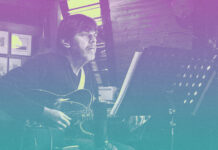Nostos, a collaboration between bassist/electronics artist Cristiano Bocci (Follonica GR) and myself, represents a melding of the organic, acoustic sounds of the double bass with after-the-fact timbres and supplementary compositional structures afforded by the creative use of electronics.
The idea for the collaboration was Cristiano’s. I’d already known and very much liked his release Instruments, in which he’d taken recordings of friends’ free improvisations on acoustic instruments and reworked them electronically into impressionistic portraits of often startling beauty. The prospect of creating a transatlantic electroacoustic work with an artist of Cristiano’s sensibility was attractive, to say the very least.
The basic process we used was to take a set of solo double bass performances I recorded at home in Silver Spring, and then to send them via the Internet to Cristiano for electronic interventions of his choosing. Most of these performances were structured improvisations consisting of variations on themes provided by recurring pitch or sound collections; one performance involved the realization of a graphic score. Once he received my files, Cristiano modified them in different ways with electronic programs or, in the case of the final track, an overdubbed, melodic improvisation.
Pitch plays an important if variable role in these pieces. Often it constitutes the center of gravity of the piece conceptually, but it is necessarily a moving center and one apt to be displaced by timbre at any given moment. This is especially true once the electronics are factored in. But even before the application of electronics, the relationship between pitch and timbre was imagined as a complex, interactive one always subject to negotiation, reprioritization, separation and even mutual identification. As it took shape in these pieces, timbre could mean pitch + timbre—an essentially pitch-rooted complex of sound—or it could mean sound mass eliding pitch, a kind of inharmonic in-itself standing in an opaque, virtually external relation to pitch.
In all of the pieces, harmony was quite consciously conceived of as an emergent property of the line. The solo performances were undertaken with the possibility of post-production overlayering in mind, and so the pitches, phrases and sounds were chosen in such a way that they would produce interesting results when arranged vertically. Superimposed lines may produce harmonies, but these harmonies were already latent in the way the lines were organized—movement from note to note encompassed consonant and dissonant intervals, potential leading tones and so forth. One performance, which became L’ultimo treno per Follonica, was built around a five tone scale with an ambiguous center; this created lyrical and harmonic possibilities that Cristiano deftly explored on six-string electric bass.
The emergence of rhythmic regularities on some of these tracks—Contrabassi in marcia in particular—was something of a surprise. In my solo performances the pacing and length of the line tend to follow the breath as an intuitive unit of measure. This is a notoriously variable unit and consequently one not ordinarily given to precise or long-form rhythmic cycles. Cristiano’s ability to hear and realize a regular rhythm in one of these performances was a case of the kind of serendipity that not only is unique to collaborations, but that makes them so attractive. A sympathetic yet other sensibility can often see things in our performances that we can’t ourselves imagine; this clearly was the case with Cristiano.
In the end, though, the pivot on which these pieces turn is timbre. The double bass is a timbrally versatile instrument thanks to the overtone structures its low-pitched strings can produce and to the variety of coloristic effects obtainable with the bow or fingers. Cristiano’s subsequent processing of my performances, whether with ring modulation, granular synthesis, or sampling in gleetchlab, actualized the vast timbral richness latent in the instrument. Through the interaction of natural acoustics and sensitive electronic processing we were able to create—to paraphrase Ad Reinhardt’s formula—music as sound as music.
Nostos is available for free download from Acustronica.







